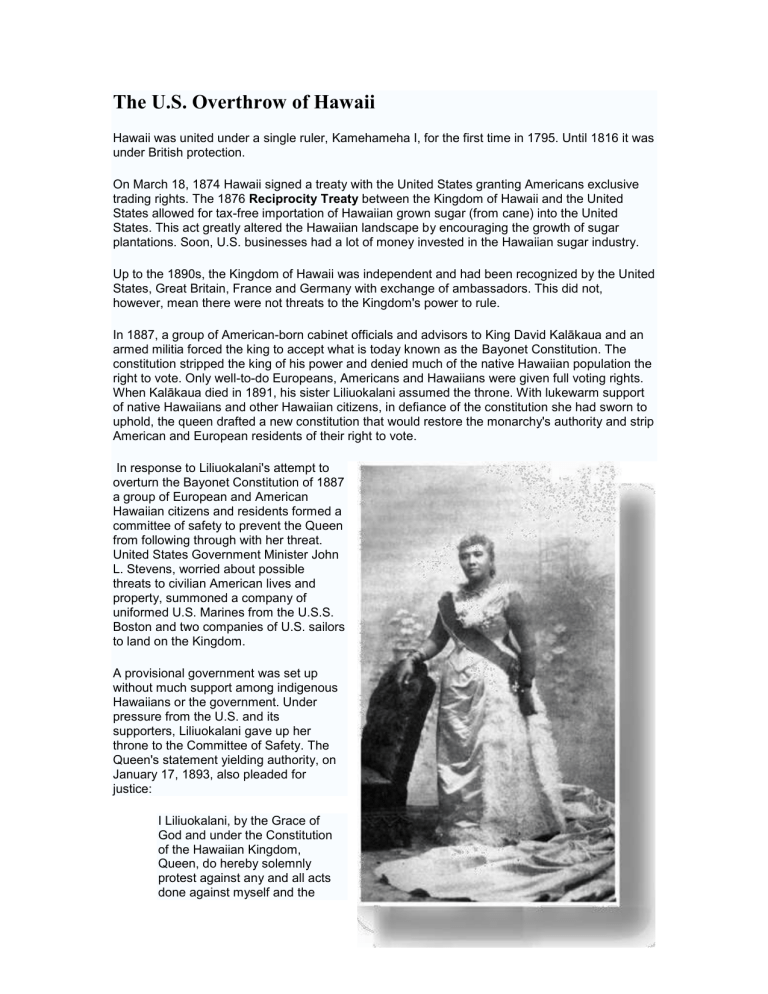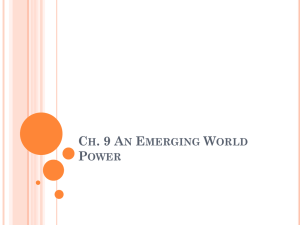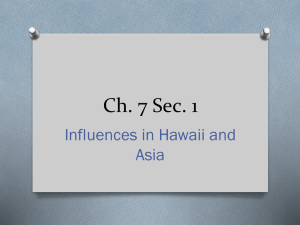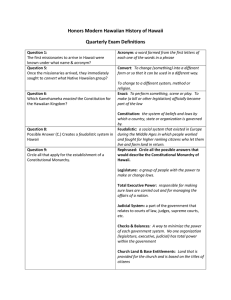US Hawaii worksheet
advertisement

The U.S. Overthrow of Hawaii Hawaii was united under a single ruler, Kamehameha I, for the first time in 1795. Until 1816 it was under British protection. On March 18, 1874 Hawaii signed a treaty with the United States granting Americans exclusive trading rights. The 1876 Reciprocity Treaty between the Kingdom of Hawaii and the United States allowed for tax-free importation of Hawaiian grown sugar (from cane) into the United States. This act greatly altered the Hawaiian landscape by encouraging the growth of sugar plantations. Soon, U.S. businesses had a lot of money invested in the Hawaiian sugar industry. Up to the 1890s, the Kingdom of Hawaii was independent and had been recognized by the United States, Great Britain, France and Germany with exchange of ambassadors. This did not, however, mean there were not threats to the Kingdom's power to rule. In 1887, a group of American-born cabinet officials and advisors to King David Kalākaua and an armed militia forced the king to accept what is today known as the Bayonet Constitution. The constitution stripped the king of his power and denied much of the native Hawaiian population the right to vote. Only well-to-do Europeans, Americans and Hawaiians were given full voting rights. When Kalākaua died in 1891, his sister Liliuokalani assumed the throne. With lukewarm support of native Hawaiians and other Hawaiian citizens, in defiance of the constitution she had sworn to uphold, the queen drafted a new constitution that would restore the monarchy's authority and strip American and European residents of their right to vote. In response to Liliuokalani's attempt to overturn the Bayonet Constitution of 1887 a group of European and American Hawaiian citizens and residents formed a committee of safety to prevent the Queen from following through with her threat. United States Government Minister John L. Stevens, worried about possible threats to civilian American lives and property, summoned a company of uniformed U.S. Marines from the U.S.S. Boston and two companies of U.S. sailors to land on the Kingdom. A provisional government was set up without much support among indigenous Hawaiians or the government. Under pressure from the U.S. and its supporters, Liliuokalani gave up her throne to the Committee of Safety. The Queen's statement yielding authority, on January 17, 1893, also pleaded for justice: I Liliuokalani, by the Grace of God and under the Constitution of the Hawaiian Kingdom, Queen, do hereby solemnly protest against any and all acts done against myself and the Constitutional Government of the Hawaiian Kingdom by certain persons claiming to have established a Provisional Government of and for this Kingdom. That I yield to the superior force of the United States of America whose Minister Plenipotentiary, His Excellency John L. Stevens, has caused United States troops to be landed at Honolulu and declared that he would support the Provisional Government. Now to avoid any collision of armed forces, and perhaps the loss of life, I do this under protest and impelled by said force yield my authority until such time as the Government of the United States shall, upon facts being presented to it, undo the action of its representatives and reinstate me in the authority which I claim as the Constitutional Sovereign of the Hawaiian Islands. A hasty investigation established by President Cleveland was conducted by former Congressman James Henderson Blount, and concluded on July 17, 1893, "United States diplomatic and military representatives had abused their authority and were responsible for the change in government." Minister Stevens was fired, and the military commander of forces in Hawaii was forced to resign his commission. President Cleveland stated "Substantial wrong has thus been done which a due regard for our national character as well as the rights of the injured people requires we should endeavor to repair the monarchy." Cleveland further stated in his 1893 State of the Union Address that, "Upon the facts developed it seemed to me the only honorable course for our Government to pursue was to undo the wrong that had been done by those representing us and to restore as far as practicable the status existing at the time of our forcible intervention." Submitting the matter to Congress on December 18, 1893, after President Sanford Dole refused to reinstate the Queen on Cleveland's command, the Senate Foreign Relations Committee under Chairman Morgan, continued investigation into the matter. On February 26, 1894, the Morgan Report was submitted which did not blame Stevens and the U.S. troops for any involvement in the overthrow. In response to this report, Cleveland backed off from his previous rhetoric surrounding the overthrow, and conducted normal diplomatic relations with the Provisional Government, and the Republic of Hawaii. He ignored pleas from the Queen to interfere further in the matter, and in a stunning turnaround accepted the legitimacy of the overthrow he had so strongly criticized. 1. Why was the U.S. interested in Hawaii? 2. How did the Reciprocity Treaty effect Hawaii? 3. What kind of government was Hawaii before the U.S. took control? 4. What did the Bayonet Constitution do? 5. Who took the throne of Hawaii after King David Kalākaua died? 6. What did the queen threaten to do? 7. What was the response to the queens threat? 8. Summarize what the queen says in her January 17, 1893 statement. 9. What was president Cleveland’s first response to what happened in Hawaii? 10. What did the Morgan Report say? 11. How did Cleveland respond to the Morgan Report? Why do you think he changed his mind about the overthrow? 12. How would you describe the actions of the U.S. in Hawaii? 13. Should Hawaii be an independent nation or a state? Why do you think so?






